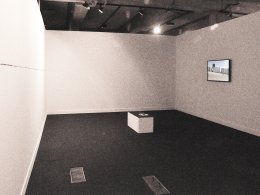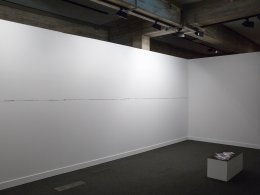Straight Line Attempt 2015
Wall installation, 10 m x H 3 m
...
During her residence, Dobbels asked herself a fascinating question. Is the fact that the Belgian coast lies more or less in a straight line purely coincidence, a mere chance of nature? After a certain amount of research, she found that this is not the case. It is the result of a dialectic between man and nature. After the Elizabeth Flood of 1404, Margaret of Male, Countess of Flanders, ordered that a dyke should be built to hold back the sea. It is still called the Count Jan Dyke, after Margaret’s son and successor, Jan the Fearless. These sea defences, large parts of which have been preserved and which also survive in street names, lie several kilometres inland from the present coastline and run from Dunkirk to Sas van Gent. The result was that the formation of dunes from the French-Belgian border to the Westerscheldt occurred more or less in a straight line. In the meantime, long stretches of dune have made way for blocks of flats. It is precisely the fact that the Belgian coastline is so straight that reinforces one of the essential functions of the exemplary flat with a view of the sea, which is the one-to-one relationship between its occupant and the sea.
... (Fragment text Frank Maes, publication Straight Line Attempt, Posture Edtions N°16)



